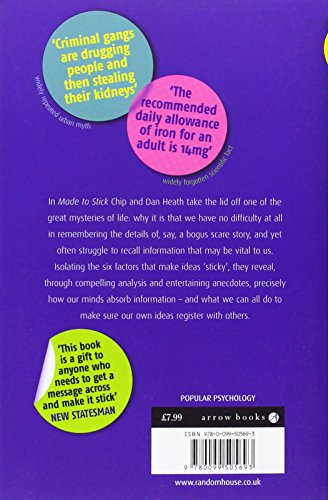Customer Services
Copyright © 2025 Desertcart Holdings Limited
Desert Online General Trading LLC
Dubai, United Arab Emirates



Made to Stick Why Some Ideas Take Hold and Others Come Unstuck by Dan Heath and Chip Heath - Paperback
F**W
Good, but too much filler
This is a reasonably decent source of information on the title subject: making ideas stick. However, I have two criticisms that aren't meant to dismiss or rubbish the book, just to put it into context:1. The useful information content is minimal and could be fitted on less than ten pages, in my opinion2. The book suffers from repetition and that American writing style of endless cameos to illustrate the point. Yes, cameos can be helpful, but the amount of writing dedicated to examples far outweighs the simple explanation of its simple principles.In summary, good basic principles that could comfortably fill a pamphlet but that have been massively padded out into a book.My suggestion: buy a used copy
N**S
A Review - for Educators
I believe this book should be compulsory reading for every educator. Indeed I will go a step further – I think it may well be more useful to us than any single book on teaching.The book is about effective and persuasive communication. The Heath brothers start with the Q: ‘Why is it that some ideas are so memorable?’ A: Six key elements [SUCCES]: i) Simplicity (Keep it simple!) ii) Unexpectedness (Surprise = retention!) iii) Concreteness (Avoid abstract or ‘deep’ messages) iv) Credible (Is it believable?) v) Emotions (It is emotion, not reason that makes people act!) vi) Story (The most memorable messages are in the form of a story).In analysing these elements they explain all kinds of interesting notions, such as ‘the curse of knowledge’ (p. 19). What would happen if you were to tap your finger to the rhythm of a well-known song without actually humming it? Would people be able to guess it? 50% of respondents said ‘Yes’. Incredibly, the actual number was 2.5%!! It is exactly the same when we try to communicate a message – we think others understand, but very often they don’t! (Moral: check that your students have really understood what you have told them or what they have to do. Get feedback as much as possible!)Heath & Heath go on to stress the importance of ‘curiosity’ (pp. 84 – 87). This is the technique that soap operas, cinema trailers and some gifted presenters use to hook the readers/listeners’ interest. (Moral: Whether it is the contents of a text, or the lesson, it pays not to tell students everything up front. We can excite their curiosity even about mundane things.)A surprising research finding on p. 89 is of great importance to us; Q: Which is better: consensus-building activities or ones encouraging heated debate? A: The latter! In a controlled study, 18% of students who had done a consensus-type activity chose to watch a short film about the topic, but the number rose to 45% among those who had engaged in a debate! (Moral: use more debates to get students worked up so they are motivated to find out more about the subject under discussion!)The two brothers also give us a host of useful tips on how to make our presentations / articles interesting (which is of course of immense value for students / adult learners). Here are a few research-supported findings: a) avoid obscure language (p. 106) b) including details makes your argument more convincing (p. 139) c) ‘translate’ statistics down to the human scale (the human brain cannot make sense of huge numbers! – p. 144).Above all however, remember to use stories. Human beings are wired for story. As somebody once so memorably put it: ‘Facts tell – stories sell!’
A**N
Very good book
Before you buy this book, read about the concept it’s covering. This covers the success of ideas/concepts and reasons behind them with examples. It’s advocates that any idea can be put through a framework to make it more sticky or successful among people. This book may not be for all but people with content writing, user experience , product management etc Anybody who has to convey the ideas.
R**W
38 pages to explain the meaning of simple?!!😴😴
Obviously the idea it's self of this book is interesting, and to be fair it does have some cool case studies inside.But that's it, the book is an absolute painful bore to read, I've tried to look past the fact of how painful the read actually is but I just can't.Chapter 2 is called ‘simple’ and has a purpose of explaining what simple means... yet it's 38 pages long🤦🏽♂️🤦🏽♂️🤦🏽♂️I highly doubt I’ll finish this one I can’t lie guys.
S**T
Some good principles but book repeats itself and overuses case studies. Could have been shorter.
The first half of the book is great, and the analogies used make it easy to understand but I found that around 2/3rds into the book there was a lot of repeating the same principles over again. I found also that there were just too many case studies and not enought narrative from the authors. Kind of like the authors didn't have enough to fill a book with their ideas so fleshed out the rest of the pages with examples. This could have been a shorter book which would have kept the readers attention better.
Trustpilot
2 weeks ago
5 days ago